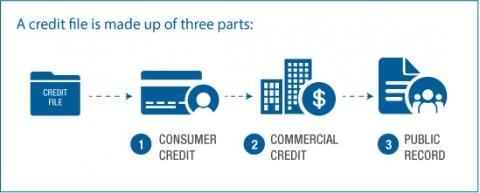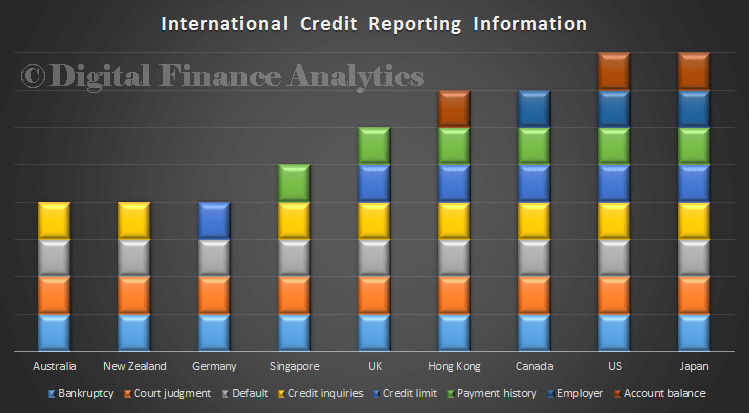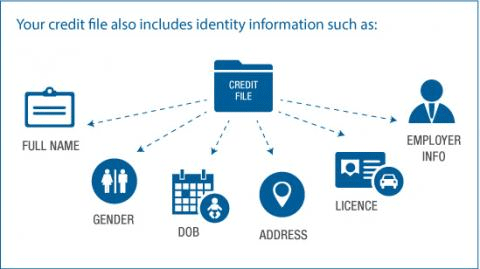
By Martin North, cross-posted from the Digital Finance Analytics blog.
Australia’s current credit reporting regime is over twenty years old and permits the collection of only “negative” data. However in March 2014 the credit assessment of potential borrowers is set to change as a result of legislation passed in 2012. Behind the scenes, players are making changes to their systems and processes to meet the deadline, from when additional data about people will be used as part of a more comprehensive “positive” credit assessment scoring. This change has largely passed under the radar so far, but we discuss today some of the implications and issues arising, and potential consequences of the reforms.
By way of background, Australia has lagged behind many other western countries by only using “negative” credit data. Essentially, this means that default events like missed payments appear on the credit registers and credit scores maintained by the credit reference agencies, like Veda, Experian or Dunn and Bradstreet. In addition some of the large banks hold private data on their customers, but this is not shared.
The USA has some of the most comprehensive credit reporting. According to the Australian Law Reform Commissions (ALRC)
In the US, credit reporting is regulated under the Fair Credit Reporting Act 1970 (US) (FCRA) by the Federal Trade Commission. The FCRA does not limit the permissible content of credit information files held by credit reporting agencies or the content of credit reports.Major credit reporting agencies in the US hold and report detailed information about individuals’ credit accounts including, but not limited to, current balances, credit limits, amounts past due, payment performance and payment status pattern and account descriptions.Credit reporting agencies receive information from credit providers and others, generally every month, and update their credit files within one to seven days of receiving new information.
In Australia, data is already collated from multiple sources according to Veda.
 The public record element includes:
The public record element includes: The Privacy (Enabling Privacy Protection) Bill 2012 enacted positive credit. The timetable is:
- November 2012: Comprehensive Credit Reporting passes Parliament
- December 2012: Royal Assent with the signature of the Governor General
- April 2013: Draft Credit reporting code is available for public consultation
- June 2013: Regulations are passed
- July 2013: Draft Credit reporting code is lodged with the OAIC: Office of the Australian Information Commissioner
- September 2013: OAIC public consultation on Credit reporting code
- December 2013: OAIC approves credit reporting code
- March 2014: New Credit reporting & Privacy Laws start
The rationale for more comprehensive credit reporting is to address the so called information asymmetry between a potential borrower and a potential lender which means the lender is not able to make an accurate assessment of the risk of a particular customer at a point in time. As a result people with good histories may be disadvantaged in terms of price, and people with poor histories may get facilities they should probably not. In addition, people with minor dents in their behaviour, for example not paying a mobile phone bill some years back, might be disadvantaged or refused credit, when they have reformed. This leads to single pricing – one size fits all. Today most lending is done on this basis in Australia. The ALRC says:
Due to problems in assessing the risk presented by individual borrowers, credit providers may charge borrowers an average interest rate that takes account of their experience of the pool of borrowers (good and bad) to whom they lend. This may cause adverse selection so that ‘some good borrowers … drop out of the credit market’, further increasing the average interest rate ‘to cover the cost of loans that are not repaid’
Positive credit assessment can therefore increase competition, and improve the relative pricing of some products for some people. People with “thin credit files” may be more able to obtain credit more easily. As a consequence of the enhanced data, default rates may be managed down, and the broader community may benefit from lower pricing due to lower loss rates. Some suggest that positive credit assessments lead to more responsible lending, though I must say, I do not think this is proven. Overseas evidence does suggest that default rates may fall after the introduction of positive assessment. What is true is that consumers will tend to be more aware of their rating, and in some cases make proactive decisions as a result.
On the down side, privacy has been traded away. More information about individuals will be captured, with all the potential issues of accuracy and security. Additional costs will be incurred in enhancing systems, and mechanisms need to be in place to deal with inaccuracies.
The new arrangements commence on the 12 March 2014, when the additional data stored from 2012 onwards will be available to authorised customers of the credit references agencies. The new additional information will include:
- Date account opened
- Current Limit of account
- Nature of credit account
- Date account closed
- Account payment history (licensed credit providers)
It will be interesting to see if banks and other credit providers start to offer a range of risk based priced products, based on the enhanced credit score available, and whether net margins are reduced. There is a significant opportunity for players to use data better to segment and target selected customer, based on their credit score.
According to the Office of the Australian Information Commissioner, a credit reference bureau (CRB) or credit provider that holds credit-related personal information about an individual must, on request by an access-seeker (generally, the individual or a person authorised in writing who is assisting the individual), give the access-seeker access to the information.
So, I will be looking out for disclosure by which consumers can inspect, and if necessary correct data on their files. Today, you have to pay a fee in the order of $70 with Veda to examine and check your data for a year. Experian offers a 10 day turn around on an individuals current credit report. Experian in the UK offers a free 1 month trial, then charges after that, but you can also get a 2 pound statutory credit report there.



